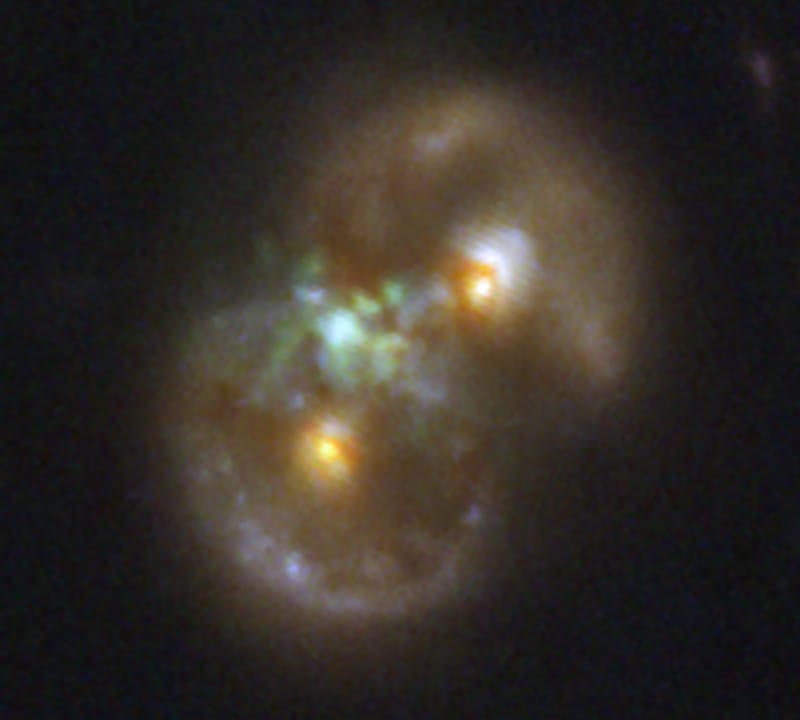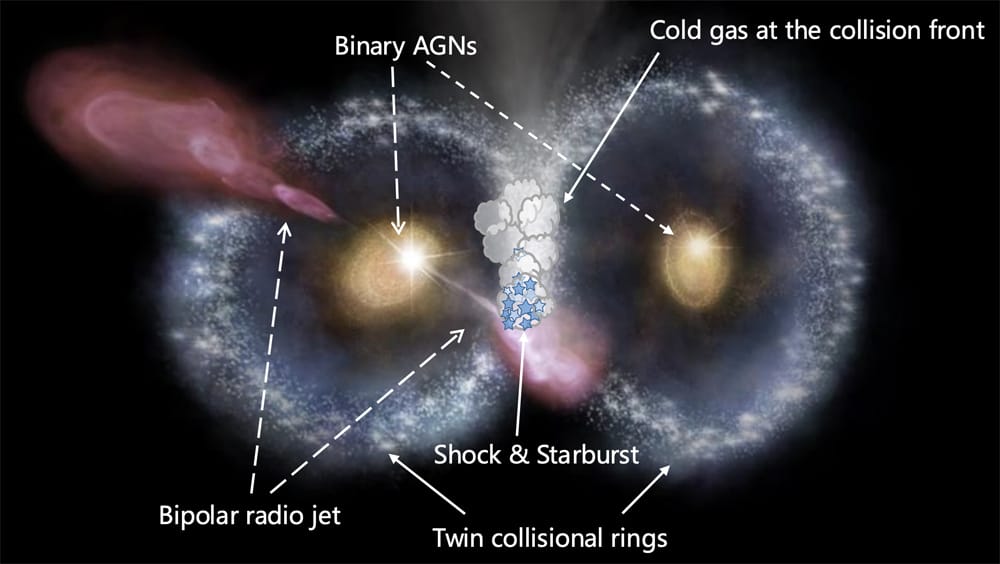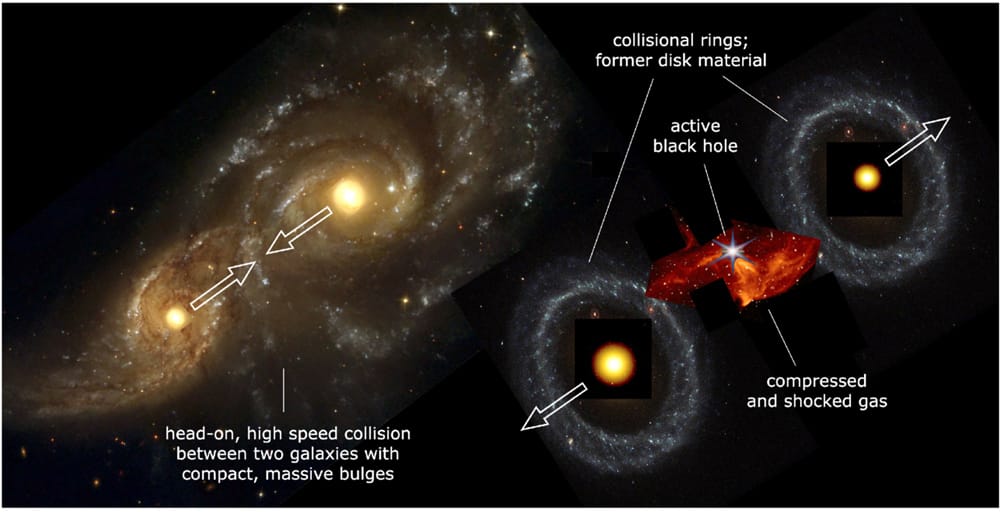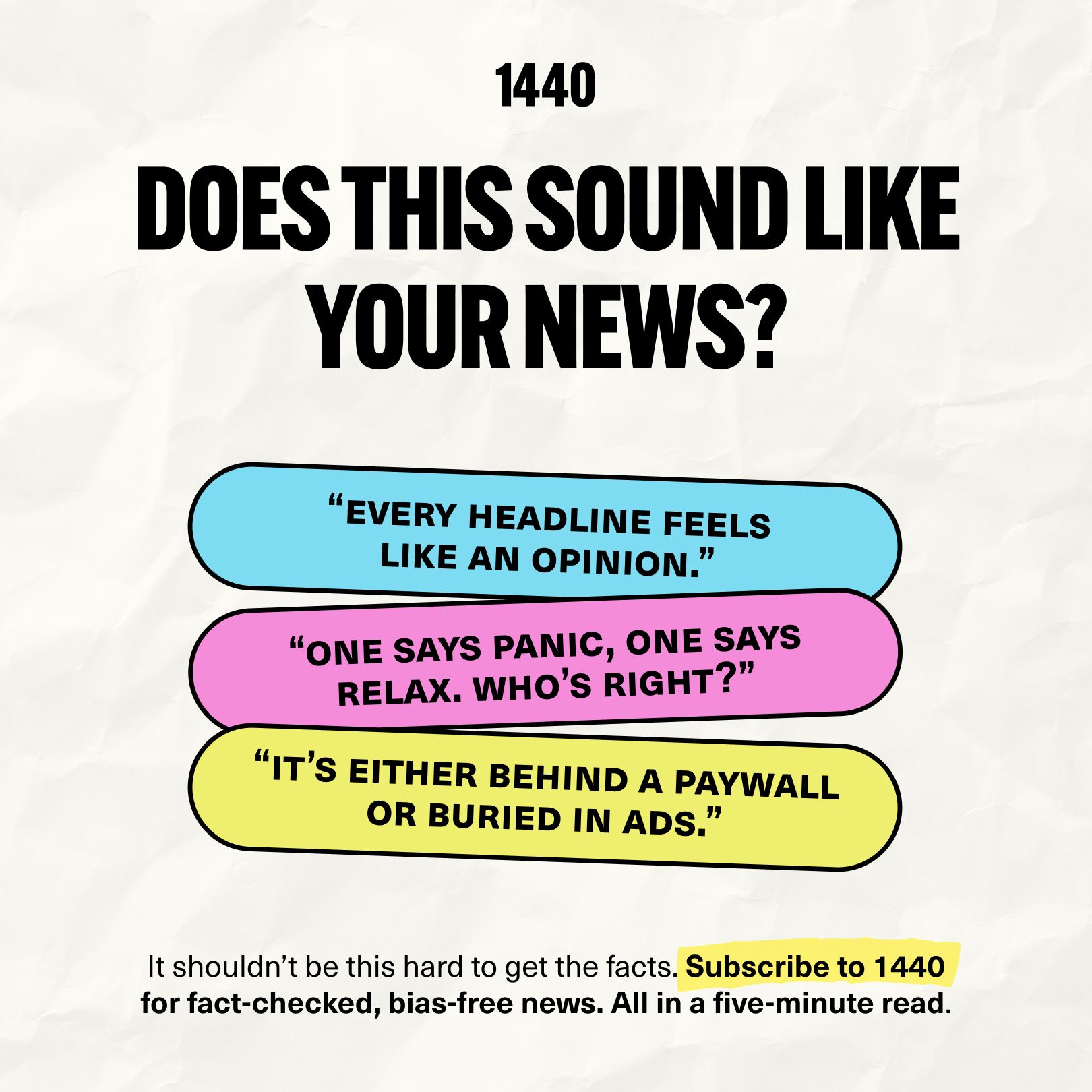- Bad Astronomy Newsletter
- Posts
- The Owl Galaxies are hiding a secret in plain sight. But what is it?
The Owl Galaxies are hiding a secret in plain sight. But what is it?
It might be a supermassive black hole, or it might be a bazillion newborn stars

The Trifid Nebula and environs. Credit: RubinObs/NOIRLab/SLAC/NSF/DOE/AURA
July 21, 2025 Issue #907
Do the Owl/Infinity Galaxies host a weird black hole, or just super-powerful star formation?
Two papers came out to explain a weird pair of galaxies, and get very different results
I do love a weird cosmic object that defies obvious explanation. It gets even better when two papers come out to explain it, and they disagree with each other on a very fundamental level!
The object in question is actually a pair of galaxies that two teams of astronomers discovered independently from each other at essentially the same time. It’s not that big of a coincidence, though: the galaxies were observed by JWST in a deep survey (called COSMOS-Web) of a relatively wide area of the sky, and the data were released to the community for analysis. The galaxy pair is rather striking, so it’s no surprise it caught the eyes of different astronomers.
One team calls them the Owl Galaxies, which is a pretty good name, since they do look like an owl [link to journal paper]. The other team calls them the Infinity Galaxies, because they resemble an infinity symbol (∞) [link to journal paper].

The Owl/Infinity Galaxies. Credit: NASA, ESA, CSA, STScI, Pieter van Dokkum (Yale)
The two teams do agree on a lot of the basics. The galaxies are about 8.3 billion light-years from Earth, about two-thirds of the way across the visible Universe. A long way! It’s remarkable we can see any details at all in such distant galaxies but in fact the JWST images do reveal some structure. The two galaxies are very similar: They both have a bright nucleus (a central blob of stars) surrounded by a ring of stuff, creating the eponymous appearance.
Looking for unbiased, fact-based news? Join 1440 today.
Join over 4 million Americans who start their day with 1440 – your daily digest for unbiased, fact-centric news. From politics to sports, we cover it all by analyzing over 100 sources. Our concise, 5-minute read lands in your inbox each morning at no cost. Experience news without the noise; let 1440 help you make up your own mind. Sign up now and invite your friends and family to be part of the informed.
Ring galaxies like this are rare, but we do see enough of them to have a good understanding of how they form. I love this part: It’s from a head-on collision! If a galaxy has a big disk (like the Milky Way or any other spiral galaxy does) and a smaller, compact galaxy collides with it dead-center — a bullseye hit! — then the disk can have powerful gravitational ripples move through it as the stars are disturbed in the orbits around the center. This can create an outward motion for the stars in the inner disk, which pile up and form a gigantic ring around the nucleus.
In this case, it looks like two disk galaxies slammed into each other! The dense nucleus of each plowed through the disk of the other, creating the rings. The two galaxies passed right through each other (stars are pretty far apart, so when galaxies collide they can sometimes just keep going), and now we see them some time after the cosmic collision. The Infinity Galaxy paper estimates it’s been about 50 million years since the event, which is consistent with how long it takes rings to form.
Both teams also agree that both galaxies in the pair are active, meaning they have central supermassive black holes that are gobbling down matter. When this happens, material can pile up in an accretion disk just outside the black hole, and it gets incredibly hot. Hot gas glows, and in this case the temperature can be millions of degrees, so the gas glows a lot. It can outshine all the stars in the galaxy combined!
They also tend to emit a lot of high-energy light like X-rays, and here’s where a smart thing astronomers did comes up: one reason this area of the sky was chosen for JWST to look at is that it’s been observed by many other observatories as well, including the Chandra X-Ray Observatory, and it confirms the Owl/Infinity galaxies are emitting X-rays, in turn confirming that both galaxies are active. Cool.
Here’s where things go awry though.
In between the two galaxies is a splash of emission, some bright material halfway between the two nuclei and offset by a bit (this is the “beak” of the Owl). It’s seen at a wavelength of about 1.5 microns by JWST. The galaxies are so far away that the expansion of the Universe redshifts their light by a factor of about 2.2, so if you correct for that you find that this material is likely hot hydrogen (which emits light at a characteristic 0.65 microns). There’s likely some other gas in there as well like oxygen and nitrogen, but the hydrogen glow means there’s a lot of gas there, right in between the two galaxies.
What’s the explanation for that?
Here’s where he two teams strongly diverge.

The Owl hypothesis: gas leftover from the collision is collapsing to form stars, aided by material blasted out from the black hole in the center of one of the galaxies. Credit: Mingyu Li at el., 2025
The Owl paper thinks this is likely due to gas clouds in each galaxy slamming into each other during the collision. While the stars move on, the momentum of giant gas clouds cancels out in a collision, so the gas more or less stops dead. The galaxies move on, leaving that gas behind. They posit that the powerful collision compressed the gas clouds triggering a vast wave of star formation as the gas collapsed (also, active black holes can emit powerful beams of matter, and one of these from one of the galaxies could be impinging on the beak, further compressing the gas). The star formation rate is about 80 solar masses per year, which is dozens of times higher than it is in our own galaxy. Massive stars are luminous, and can light up the hydrogen around them. Plus, huge star-forming regions can create powerful radio waves, and observations with the Very Large Array radio observatory shows radio emission coming from the beak.
The Infinity team disagrees, though. They interpret this structure as consistent with a third active supermassive black hole! The differences in emission are subtle, but they find that the ratio of the brightness of the light emitted by oxygen to hydrogen precludes it being a big burst of star birth, and instead is from gas surrounding a black hole with about a million times the mass of the Sun.

The Infinity hypothesis: two galaxies collide (left, from an actual image of the galaxies NGC 2207 and IC 2163) and after they pass form ring galaxies (right, exemplified by the Cartwheel Galaxy) and a supermassive black hole between them. Credit: van Dokkum et al. 2025
If that’s true, how it did it get there? They go through some possible scenarios, but one of them (which earned them a press release from the folks at JWST) is that it started out as gas stopped cold in space by the collision, which then began to collapse. Normally this would form tons of stars (which is what the Owl paper proposes) but the Infinity team instead speculates that internal turbulence prevented the gas from forming stars, and instead collapsed down so much it turned directly into a black hole.
Well, that would be cool! It’s thought that this might have happened in the early Universe. We know all big galaxies have supermassive black holes in their centers, but JWST observations have shown some that are much bigger than expected in the early days if the cosmos; it takes time for a black hole to grow, and these galaxies wouldn’t have had time since they formed to do so. One solution is for the gas that formed the galaxies to collapse directly down into massive black holes (called “seed” black holes) which then are able to grow more quickly. This is still pretty theoretical though, and it’s not clear if it actually happens or not. If the Infinity team is right, then this is the first evidence such an event can transpire.
That’s a mighty big if though. While interesting, in my opinion the star formation idea is more likely; we know that happens after collisions, and much of the observations fit it. The oxygen/hydrogen ratio claimed by the Infinity team is really the only stumbling block, and that could be due to any number of other things. Also, the idea of this being a third supermassive black hole (again, IMO) is a bit too speculative for my own preferences. I’m not saying it’s wrong, I’m saying that from my experience it’s less likely than the far more common effect of a burst of star birth.
So, we have two teams looking at essentially the same data and drawing vastly different conclusions! That’s fun. I expect they will be eagerly reading each other’s work and trying to find flaws or strengths to compare with their own. I also expect more papers will be coming out soon about this. I’ll be very interested to see where they fall, and what the community at large thinks as well.
This is science, folks! Interpretations of evidentiary paths can diverge, and don’t always lead to the same destination. One or the other may prove correct, or maybe there’s a third solution no one has thought of yet. All we can do is let the scientists with decades of experience hash it out, and see what comes out on top.
Et alia
You can email me at [email protected] (though replies can take a while), and all my social media outlets are gathered together at about.me. Also, if you don’t already, please subscribe to this newsletter! And feel free to tell a friend or nine, too. Thanks!



Reply